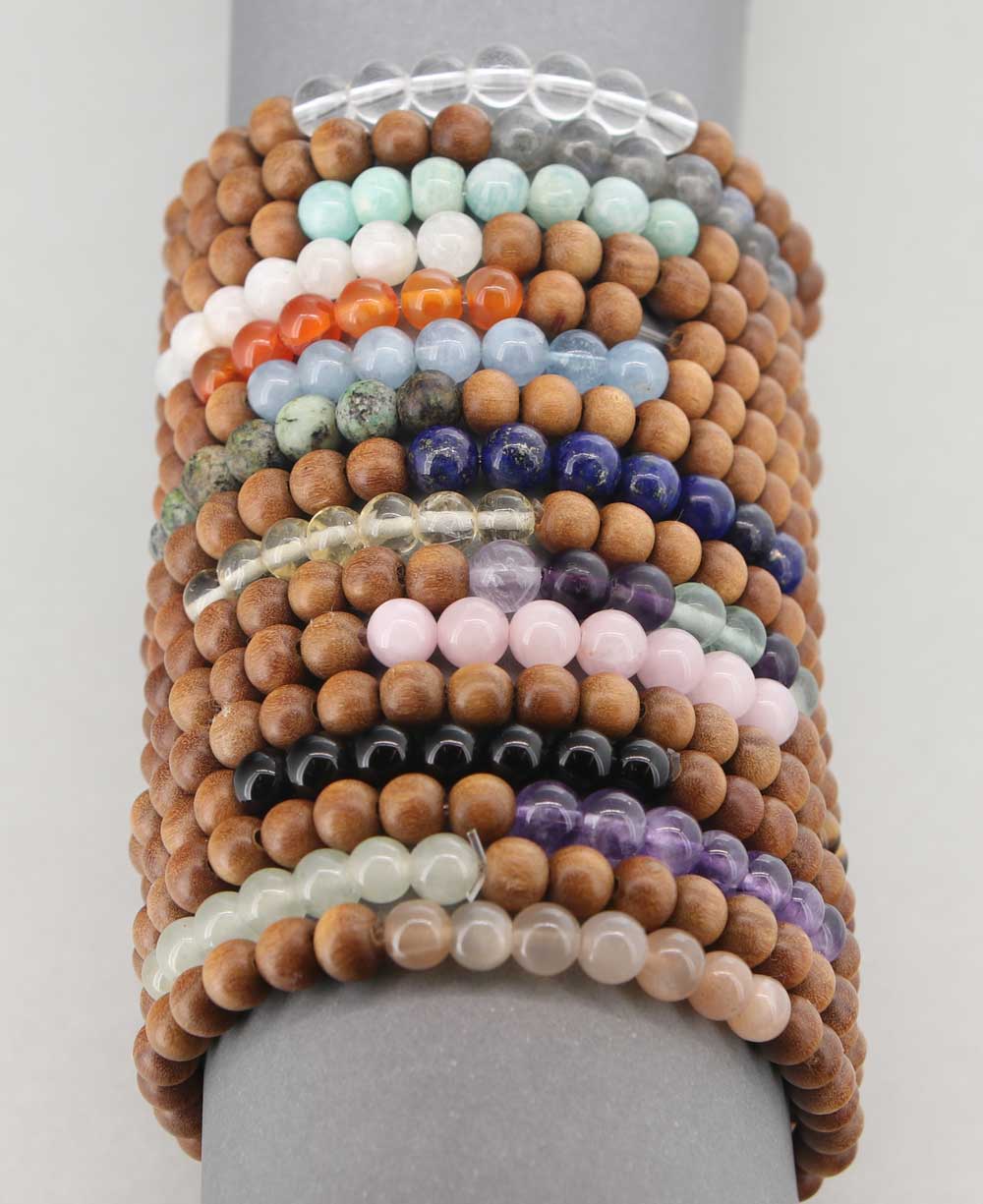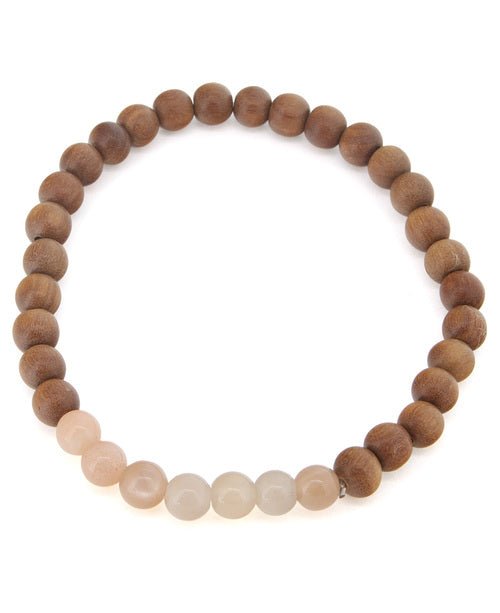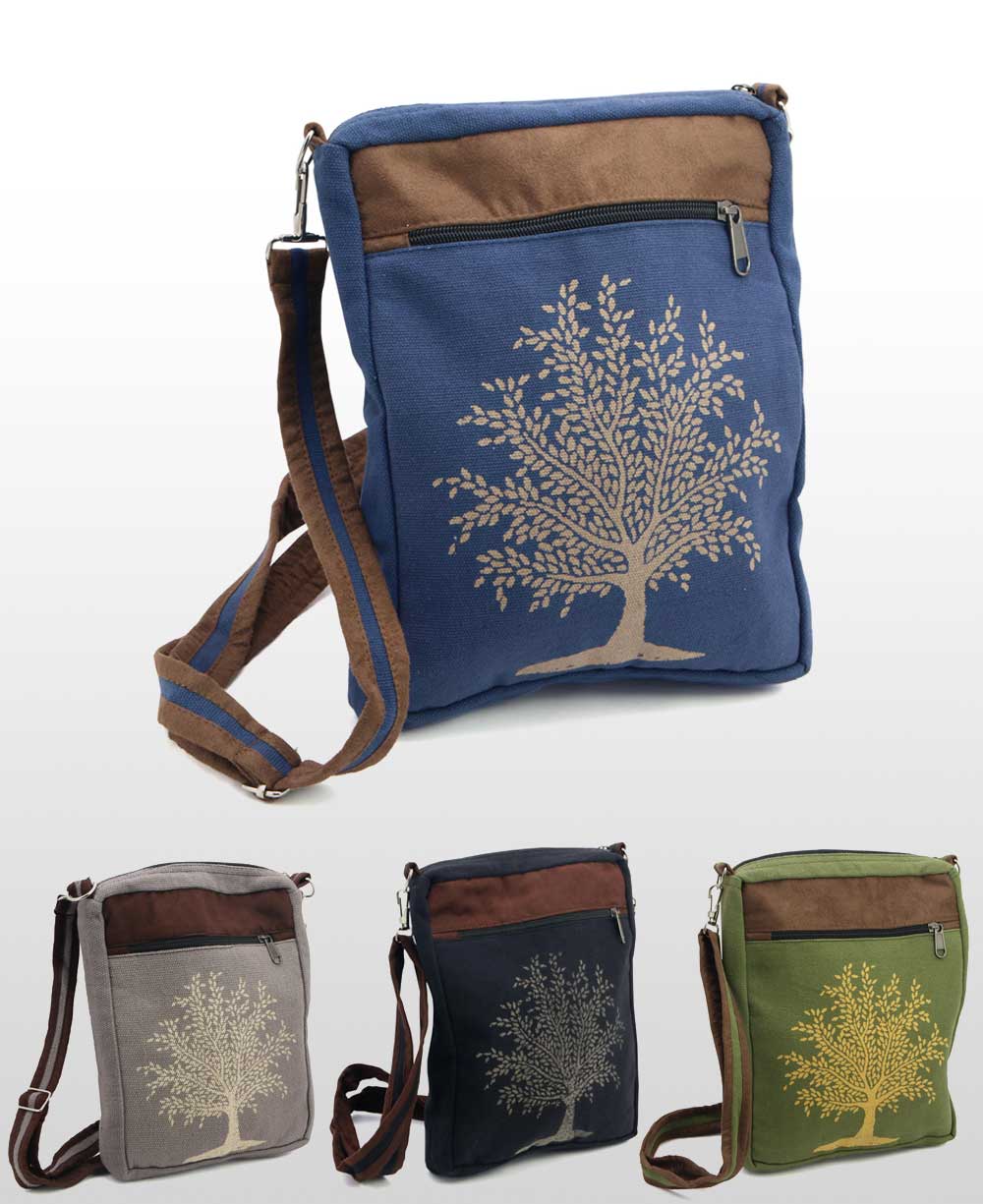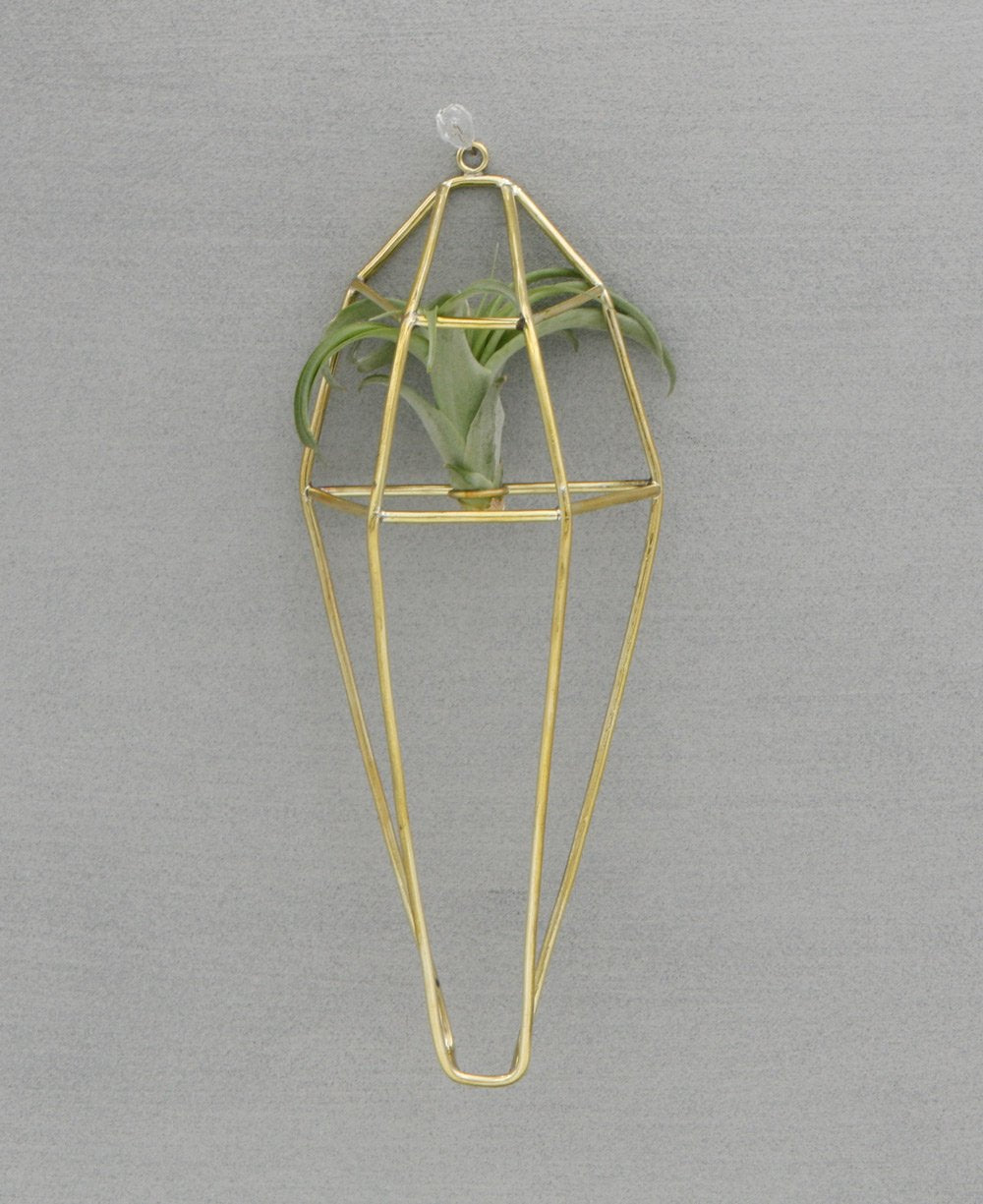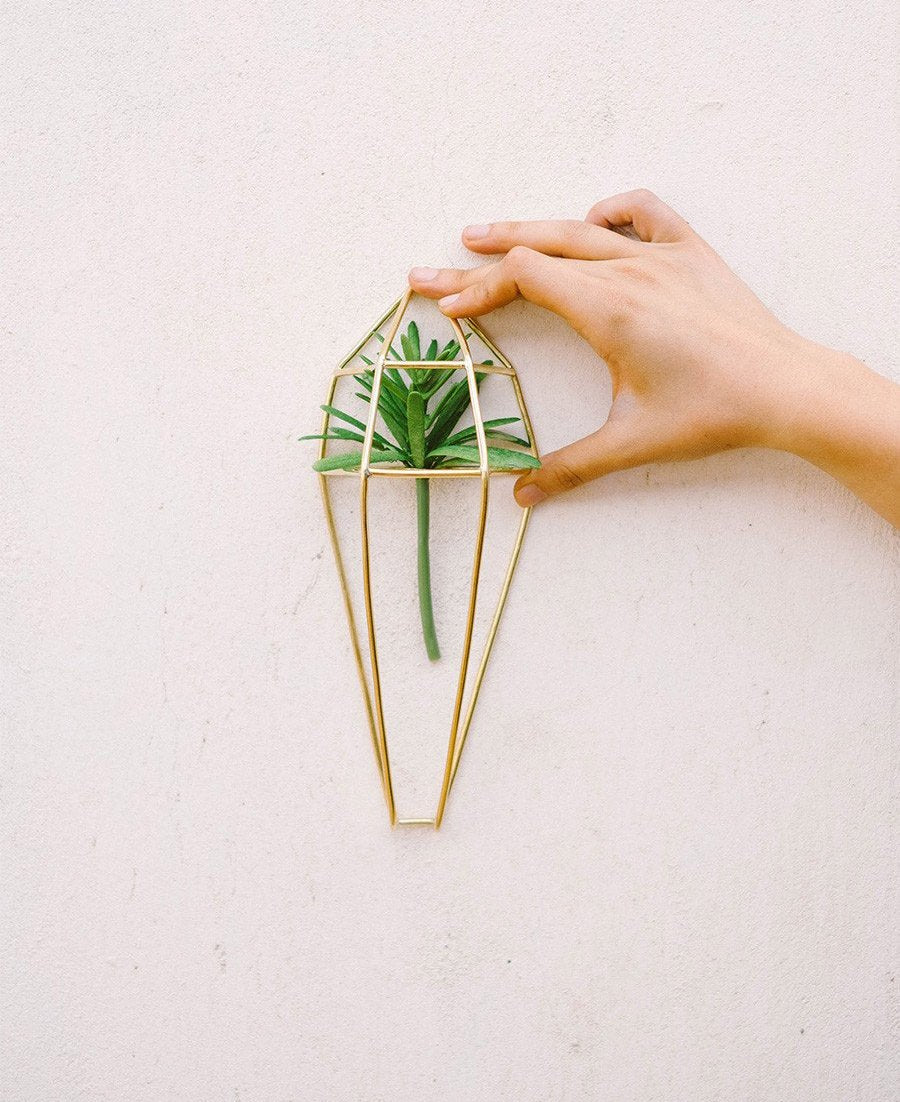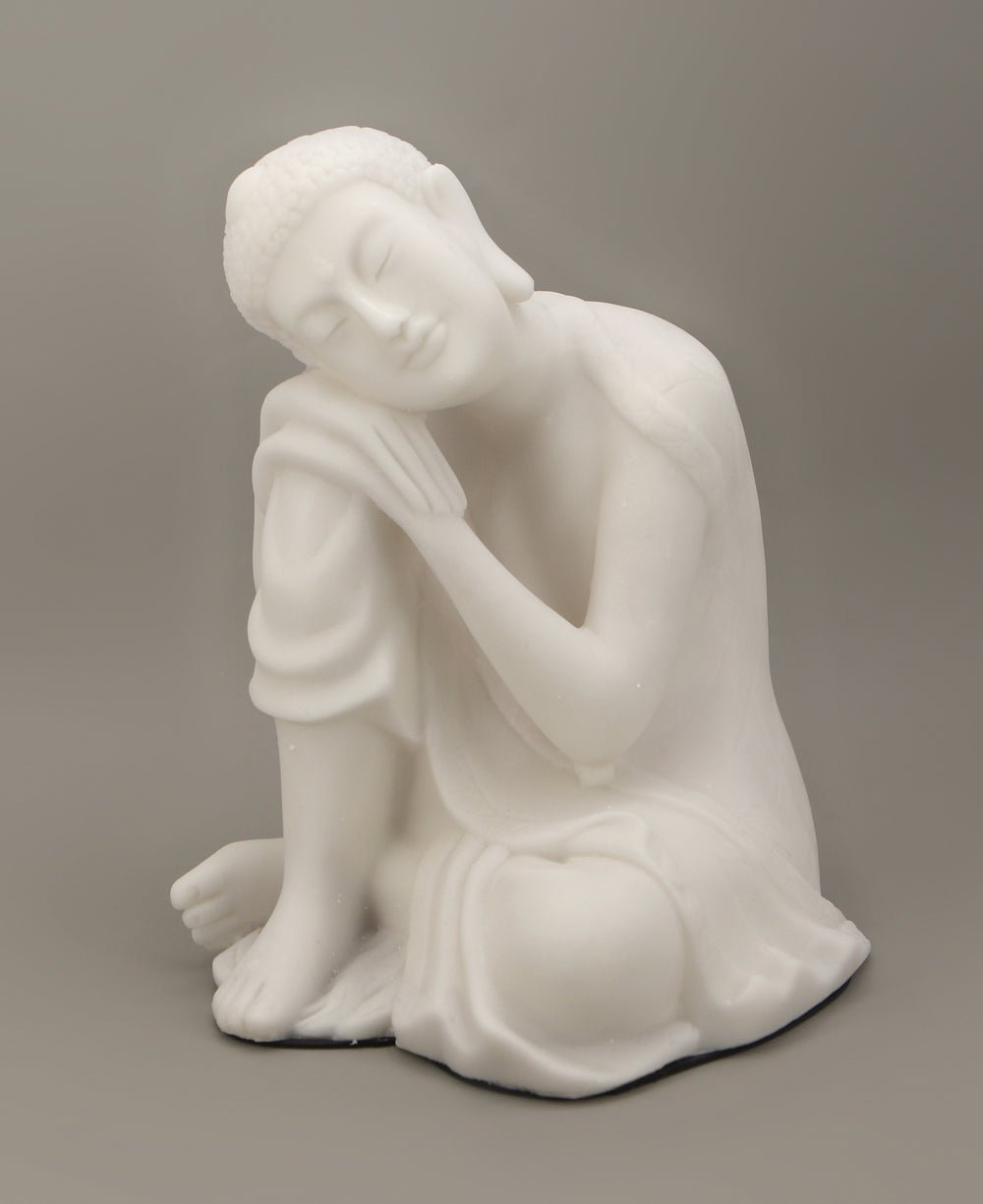Meditation Mala Guide
How To Use Mala Beads / Introduction To Mala Beads
You’ve seen them in yoga studios. You’ve seen them worn as spiritual jewelry. And you may have even seen them held by the Buddha. What are these mysterious bead chains? Where do they come from? Who uses them? And how can they help with meditation?
These special beads are called malas (or japa malas), and they have been in existence for thousands of years. You can find them almost anywhere in the world, although their earliest origins stem from India and Nepal – where meditation has been practiced longest. Today anyone can use mala beads as a way to create calm and peace of mind in everyday life. Malas are used in traditional prayer and meditation, although anyone can begin to use malas without prior experience.
Each mala contains a set number of beads (usually 108) representing spiritual identity and connection with the universe. In meditation the idea is to move one bead at a time, using each movement as an opportunity to focus on a breath or mantra. This process creates positive spiritual energy – known as ‘japa.’
Every mala is unique – and there is a lot to know and learn about their individual properties and materials before beginning meditation.
What Are Malas Made Of?
Traditional malas are made using organic materials such as plant seed, wood, and animal bone, which are carved or shaped into rounded beads. Historically, malas made of Rudraksha seed are thought to carry special significance, as the seed is believed to hold spiritual and healing power. Similarly, malas made from Bodhi seeds represent the ancient fig tree under which Buddha attained enlightenment more than 3,000 years ago.
Mala beads made from carved bone are common in Tibetan culture – signifying impermanence and the necessity for compassion during our time in this world. And mala beads made from wood or tagua nut represent a spiritual connection with the earth – great for promoting mindfulness and grounding energy during meditation.
Malas can be made using a wide variety of gemstones with specific healing properties. For example, rose quartz (pink) promotes compassion, lapis (blue) helps calm the mind, and amethyst (purple) is believed to enhance clarity of thought. Malas can also be made of metal, shell, or other materials that can be inscribed or painted with words, symbols, and mantras.
Due to the natural qualities of most materials, no two malas will ever appear exactly the same – making each one a symbolic and highly personal addition to meditation practice.
What Are The Different Kinds Of Malas?
A standard japa mala will usually contain 108 beads, the number representing the coordinates of the spiritual center of the universe. The guru bead (largest bead at the top, or the bead marked with a tassel) represents the sacred bond of the student-teacher relationship. Therefore, when meditating, it is advised to turn around and reverse directions when you reach the guru bead – to avoid “stepping over” one’s teacher.
A full-length mala also may contain spacer beads or counter beads, which divide the mala into 4 sections of 27 beads each. Mala beads may also come in individual lengths of 54, 27, and 21 beads, with mala bracelets as small as 18 beads. Certain malas are made with stretchy or elastic cords, allowing them to be wrapped around the wrist and worn as bracelets, while others come with adjustable pull cords to fit over a range of wrist sizes.
While full-length malas appear to be the same length as necklaces, they should be handled carefully, as not all malas can be worn as jewelry.
Meditating With A Mala
Using a meditation mala requires no prior knowledge of traditions, prayers or rituals. All you need is a clear place to sit and about 10-15 minutes of uninterrupted time. Start with the mala in your left hand, with index finger and thumb lightly grasping the bead next to the Guru Bead (the larger bead at the top of the chain). Breathe deeply several times until you feel relaxed. Then, begin.
Move the beads through your fingertips, one-by-one, breathing deeply and slowly with each movement. This smooth sequence transmits information from the muscles to the brain, and relaxes the central nervous system by initiating a steady, repetitive physical motion (similar to the idea of squeezing a stress ball).
With each new bead you should be repeating a chosen mantra, prayer or intention. The mantra can be anything- some practitioners use “Om,” while others choose “peace” or “love”- and it can be spoken, whispered or hummed. Each repetition generates positive forward momentum and strengthens mental focus. If a stray thought distracts you, return to the bead where you lost concentration and start again. Meditation is not a race; there is no finish line. Meditation is a process of slow healing, of bringing a sense of infinite peace to the heart and mind.
Keep the beads moving. When you reach the Guru Bead again, you will have completed a full cycle. Come out of meditation gently by sitting in silence for some moments. Take deep breaths, stand and return to your normal activities. Remember, it takes time and practice for the mind to be able to effectively slow down and focus. Do not be discouraged if you don’t feel “perfect” the first time you meditate.
Meditation Malas Q+A
1. What are malas?
A mala is a set of beads used for meditation and prayer. Anyone can use or wear mala beads as a way to create calm and peace in daily life.
2. Why are there so many beads?
A mala usually contains 108 beads because this number is closely tied to spiritual wellbeing in many traditions. However you can find malas in a variety of bead counts!
3. Where do malas come from?
Meditation malas have been used for thousands of years in many traditions across the world. Today they are popular everywhere, although many are made in India, Indonesia (Bali), China and Nepal.
4. What are mala gemstones?
A mala often contains one or more gemstones believed to have specific healing energies. For example, rose quartz (pink) promotes compassion, lapis (blue) helps calm the mind, and amethyst (purple) enhances clarity of thought.
5. Who can wear malas?
While traditionally rooted in Buddhism and Hinduism, malas can be worn by anyone without preference towards spiritual background. Because of their creative appeal, malas may also be found in art, fashion and other modern mediums. However please note that certain gemstone will not last as long, if worn as jewelry.
6. How do I choose a mala?
You may be drawn to a particular color combination, certain gemstone energy, or more organic quality (like Rudraksha malas, made of natural “sacred seeds”). Malas come in such a wide variety precisely because no two people will experience the exact same benefits from just one kind of mala.
7. How do I use my mala?
Malas are used to count mantras (spoken intentions). Move through the beads one at a time, using your thumb to turn each bead, as you repeat a personal or traditional mantra. Stop when you reach the guru bead (the larger bead dangling from the top), this means it is time to reflect. Come out of meditation gently, and do not worry about feeling “perfect” the first few times you practice.
8. Do I use my left hand or my right hand?
The “correct” hand varies from tradition to tradition. If just starting out, it is probably best to begin with whichever hand feels most natural for you. When moving the beads through your fingers, many people choose to use the thumb and the middle finger, as the pointer finger represents the “I” or the ego, and should therefore be avoided.
9. How do I protect my mala?
Meditation malas should be kept in a small bag or storage box when not in use. While they are undeniably beautiful, many meditation malas are made of delicate materials and do not fare well when left to be damaged in open environments.
10. What are mala bracelets?
Mala bracelets are a great alternative to full length (108 beads) malas. You can wear these items around your wrist wherever you go, enabling meditation practice no matter where your travels take you. Different gemstones and colors make mala bracelets an awesome fashion statement as well.
You’ve seen them in yoga studios. You’ve seen them worn as spiritual jewelry. And you may have even seen them held by the Buddha. What are these mysterious bead chains? Where do they come from? Who uses them? And how can they help with meditation?
These special beads are called malas (or japa malas), and they have been in existence for thousands of years. You can find them almost anywhere in the world, although their earliest origins stem from India and Nepal – where meditation has been practiced longest. Today anyone can use mala beads as a way to create calm and peace of mind in everyday life. Malas are used in traditional prayer and meditation, although anyone can begin to use malas without prior experience.
Each mala contains a set number of beads (usually 108) representing spiritual identity and connection with the universe. In meditation the idea is to move one bead at a time, using each movement as an opportunity to focus on a breath or mantra. This process creates positive spiritual energy – known as ‘japa.’
Every mala is unique – and there is a lot to know and learn about their individual properties and materials before beginning meditation.
What Are Malas Made Of?
Traditional malas are made using organic materials such as plant seed, wood, and animal bone, which are carved or shaped into rounded beads. Historically, malas made of Rudraksha seed are thought to carry special significance, as the seed is believed to hold spiritual and healing power. Similarly, malas made from Bodhi seeds represent the ancient fig tree under which Buddha attained enlightenment more than 3,000 years ago.
Mala beads made from carved bone are common in Tibetan culture – signifying impermanence and the necessity for compassion during our time in this world. And mala beads made from wood or tagua nut represent a spiritual connection with the earth – great for promoting mindfulness and grounding energy during meditation.
Malas can be made using a wide variety of gemstones with specific healing properties. For example, rose quartz (pink) promotes compassion, lapis (blue) helps calm the mind, and amethyst (purple) is believed to enhance clarity of thought. Malas can also be made of metal, shell, or other materials that can be inscribed or painted with words, symbols, and mantras.
Due to the natural qualities of most materials, no two malas will ever appear exactly the same – making each one a symbolic and highly personal addition to meditation practice.
What Are The Different Kinds Of Malas?
A standard japa mala will usually contain 108 beads, the number representing the coordinates of the spiritual center of the universe. The guru bead (largest bead at the top, or the bead marked with a tassel) represents the sacred bond of the student-teacher relationship. Therefore, when meditating, it is advised to turn around and reverse directions when you reach the guru bead – to avoid “stepping over” one’s teacher.
A full-length mala also may contain spacer beads or counter beads, which divide the mala into 4 sections of 27 beads each. Mala beads may also come in individual lengths of 54, 27, and 21 beads, with mala bracelets as small as 18 beads. Certain malas are made with stretchy or elastic cords, allowing them to be wrapped around the wrist and worn as bracelets, while others come with adjustable pull cords to fit over a range of wrist sizes.
While full-length malas appear to be the same length as necklaces, they should be handled carefully, as not all malas can be worn as jewelry.
Meditating With A Mala
Using a meditation mala requires no prior knowledge of traditions, prayers or rituals. All you need is a clear place to sit and about 10-15 minutes of uninterrupted time. Start with the mala in your left hand, with index finger and thumb lightly grasping the bead next to the Guru Bead (the larger bead at the top of the chain). Breathe deeply several times until you feel relaxed. Then, begin.
Move the beads through your fingertips, one-by-one, breathing deeply and slowly with each movement. This smooth sequence transmits information from the muscles to the brain, and relaxes the central nervous system by initiating a steady, repetitive physical motion (similar to the idea of squeezing a stress ball).
With each new bead you should be repeating a chosen mantra, prayer or intention. The mantra can be anything- some practitioners use “Om,” while others choose “peace” or “love”- and it can be spoken, whispered or hummed. Each repetition generates positive forward momentum and strengthens mental focus. If a stray thought distracts you, return to the bead where you lost concentration and start again. Meditation is not a race; there is no finish line. Meditation is a process of slow healing, of bringing a sense of infinite peace to the heart and mind.
Keep the beads moving. When you reach the Guru Bead again, you will have completed a full cycle. Come out of meditation gently by sitting in silence for some moments. Take deep breaths, stand and return to your normal activities. Remember, it takes time and practice for the mind to be able to effectively slow down and focus. Do not be discouraged if you don’t feel “perfect” the first time you meditate.
Meditation Malas Q+A
1. What are malas?
A mala is a set of beads used for meditation and prayer. Anyone can use or wear mala beads as a way to create calm and peace in daily life.
2. Why are there so many beads?
A mala usually contains 108 beads because this number is closely tied to spiritual wellbeing in many traditions. However you can find malas in a variety of bead counts!
3. Where do malas come from?
Meditation malas have been used for thousands of years in many traditions across the world. Today they are popular everywhere, although many are made in India, Indonesia (Bali), China and Nepal.
4. What are mala gemstones?
A mala often contains one or more gemstones believed to have specific healing energies. For example, rose quartz (pink) promotes compassion, lapis (blue) helps calm the mind, and amethyst (purple) enhances clarity of thought.
5. Who can wear malas?
While traditionally rooted in Buddhism and Hinduism, malas can be worn by anyone without preference towards spiritual background. Because of their creative appeal, malas may also be found in art, fashion and other modern mediums. However please note that certain gemstone will not last as long, if worn as jewelry.
6. How do I choose a mala?
You may be drawn to a particular color combination, certain gemstone energy, or more organic quality (like Rudraksha malas, made of natural “sacred seeds”). Malas come in such a wide variety precisely because no two people will experience the exact same benefits from just one kind of mala.
7. How do I use my mala?
Malas are used to count mantras (spoken intentions). Move through the beads one at a time, using your thumb to turn each bead, as you repeat a personal or traditional mantra. Stop when you reach the guru bead (the larger bead dangling from the top), this means it is time to reflect. Come out of meditation gently, and do not worry about feeling “perfect” the first few times you practice.
8. Do I use my left hand or my right hand?
The “correct” hand varies from tradition to tradition. If just starting out, it is probably best to begin with whichever hand feels most natural for you. When moving the beads through your fingers, many people choose to use the thumb and the middle finger, as the pointer finger represents the “I” or the ego, and should therefore be avoided.
9. How do I protect my mala?
Meditation malas should be kept in a small bag or storage box when not in use. While they are undeniably beautiful, many meditation malas are made of delicate materials and do not fare well when left to be damaged in open environments.
10. What are mala bracelets?
Mala bracelets are a great alternative to full length (108 beads) malas. You can wear these items around your wrist wherever you go, enabling meditation practice no matter where your travels take you. Different gemstones and colors make mala bracelets an awesome fashion statement as well.






